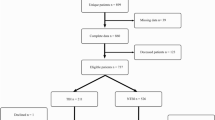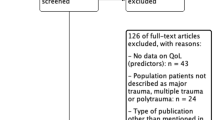Abstract
Purpose
Due to an increasing number of survivors after multiple injuries in Western countries, the health-related quality of life (QoL) is considered to be an important outcome parameter. Up to now, measuring instruments used in this field lacked validity and comparability. Within 6 years, our working group developed a new modular instrument, called the Polytrauma Outcome (POLO) chart. This study documents the validation of the trauma-specific module specifically designed for trauma patients, the Trauma Outcome Profile (TOP).
Methods
A total of 172 multiply injured patients (mean Injury Severity Score [ISS] 26.7) recruited from eight trauma centres participating in the German Trauma Registry were compared with 166 marginally injured patients (mean ISS 3.9). The mean follow-up was 24.2 and 26.4 months, respectively. The validation questionnaires used were the Beck Depression Inventory (BDI), the State-Trait Anxiety Inventory (STAI), Impact of Event Scale—Revised (IES-R), Social Support Questionnaire (F-SOZU-K-22), Barthel Index of Activities of Daily Living (ADL) and the Short Form Health Survey (SF-36).
Results
The internal consistency of the different dimensions of QoL assessed with the TOP was good. Factor analysis provides evidence of the construct validity of the questionnaire. Correlation with external measures gives evidence of criterion validity for the various dimensions of QoL and similar exceedance of proposed cut-off points within TOP and external measures is verified.
Conclusion
The TOP module is a reliable and valid instrument to assess health-related QoL in patients with multiple injuries. It can be used stand-alone or as part of the POLO chart together with the Glasgow Outcome Scale (GOS), the EuroQoL and the SF-36 as a regular systematic follow-up instrument.

Similar content being viewed by others
References
Anke AGW, Stenehjem AE, Stanghelle JK. Pain and life quality within 2 years of spinal cord injury. Paraplegia. 1995;33:555–9.
Masson F, Maurette P, Salmi LR, et al. Prevalence of impairments 5 years after a head injury, and their relationship with disabilities and outcome. Brain Inj. 1996;10:487–97.
Mayou R, Simkin S, Threlfall J. The effects of road traffic accidents on driving behaviour. Injury. 1991;22:365–8.
van der Sluis CK, Eisma WH, Groothoff JW, et al. Long-term physical, psychological and social consequences of severe injuries. Injury. 1998;29:281–5.
Mayou R, Bryant B. Psychiatry of whiplash neck injury. Br J Psychiatry. 2002;180:441–8.
Mayou R, Bryant B, Duthie R. Psychiatric consequences of road traffic accidents. BMJ. 1993;307:647–51.
Kühn M, Ehlert U, Rumpf HJ, et al. Onset and maintenance of psychiatric disorders after serious accidents. Eur Arch Psychiatry Clin Neurosci. 2006;256:497–503.
Bull JP. Disabilities caused by road traffic accidents and their relation to severity scores. Accid Anal Prev. 1985;17:387–97.
Cornes P, Bochel HM, Aitken RC. Rehabilitation and return to work of employers’ liability claimants. Int J Rehabil Res. 1986;9:119–28.
Pirente N, Gregor A, Bouillon B, et al. Lebensqualität schwerstverletzter Patienten ein Jahr nach dem Trauma eine Matched-pair-Studie im Vergleich zu einer gesunden Kontrollgruppe. Unfallchirurg. 2001;104:57–63.
Mayou RA, Ehlers A, Bryant B. Posttraumatic stress disorder after motor vehicle accidents: 3-year follow-up of a prospective longitudinal study. Behav Res Ther. 2002;40:665–75.
Mayou R, Bryant B. Outcome 3 years after a road traffic accident. Psychol Med. 2002;32:671–5.
Strohmyer LL, Noroian EL, Patterson LM, et al. Adaptation six months after multiple trauma: a pilot study. J Neurosci Nurs. 1993;25:30–7.
Mayou R, Tyndel S, Bryant B. Long-term outcome of motor vehicle accident injury. Psychosom Med. 1997;59:578–84.
Bullinger M. Assessing health related quality of life in medicine. An overview over concepts, methods and applications in international research. Restor Neurol Neurosci. 2002;20:93–101.
Neugebauer E, Troidl H. Meran consensus conference on pain after surgery and trauma. A consensus conference with various clinical disciplines and basic research, 10–14 May 1988 in Meran, South Tyrol, Italy. Theor Surg. 1989;3:220–4.
Neugebauer E, Troidl H, Wood-Dauphinee S, et al. Quality-of-life assessment in surgery. Theor Surg. 1991;6:121–2.
Pirente N, Bouillon B, Schäfer B, et al. Systematische Entwicklung eines Messinstruments zur Erfassung der gesundheitsbezogenen Lebensqualität beim polytraumatisierten Patienten Die Polytrauma-Outcome- (POLO-)Chart. Unfallchirurg. 2002;105:413–22.
Pirente N, Ottlik Y, Lefering R, et al. Quality of life in multiply injured patients. Development of the trauma outcome profile (TOP) as part of the modular polytrauma outcome (POLO) chart. Eur J Trauma. 2006;32:44–62.
Neugebauer E, Bouillon B, Bullinger M, et al. Quality of life after multiple trauma—summary and recommendations of the consensus conference. Restor Neurol Neurosci. 2002;20:161–7.
Jennett B, Bond M. Assessment of outcome after severe brain damage. A practical scale. Lancet. 1975;1:480–4.
The EuroQol Group. EuroQol—a new facility for the measurement of health-related quality of life. The EuroQol Group. Health Policy. 1990;16:199–208.
Ware JE Jr, Gandek B, Kosinski M, et al. The equivalence of SF-36 summary health scores estimated using standard and country-specific algorithms in 10 countries: results from the IQOLA Project. International Quality of Life Assessment. J Clin Epidemiol. 1998;51:1167–70.
Carmines EG, Zeller RA. Reliability and validity assessment. Quantitative applications in the social sciences. Beverly Hills: Sage; 1979.
Hautzinger M, Bailer M, Worall H, et al. Beck-Depressions-Inventar (BDI). Bern: Verlag Hans Huber; 1994.
Laux L, Glanzmann P, Schaffner P, et al. Das State-Trait-Angstinventar (STAI). Göttingen: Testzentrale; 1981.
Maercker A, Schützwohl M. Erfassung von psychischen Belastungsfolgen: die Impact of Event Skala-revidierte Version (IES-R). Diagnostica. 1998;44:130–41.
Ferring D, Filipp SH. Teststatistische Überprüfung der Impact of Event-Skala: Befunde zu Reliabilität und Stabilität. Diagnostica. 1994;40:344–62.
Sommer G, Fydrich Th. Soziale Unterstützung. Diagnostik, Konzepte, F-SOZU. Tübingen: Deutsche Gesellschft für Verhaltenstherapie (DGVT); 1989.
Bullinger M, Kirchberger, I. Der SF-36 Fragebogen zum Gesundheitszustand: Handanweisung. Goettingen: Hogrefe-Verlag für Psychologie; 1998.
Mahoney FI, Barthel DW. Functional evaluation: the Barthel Index. Md State Med J. 1965;14:61–5.
Shah S, Vanclay F, Cooper B. Improving the sensitivity of the Barthel Index for stroke rehabilitation. J Clin Epidemiol. 1989;42:703–9.
Michaels AJ, Michaels CE, Smith JS, et al. Outcome from injury: general health, work status, and satisfaction 12 months after trauma. J Trauma. 2000;48:841–8.
MacKenzie EJ, Morris JA Jr, Jurkovich GJ, et al. Return to work following injury: the role of economic, social, and job-related factors. Am J Public Health. 1998;88:1630–7.
Christensen MC, Banner C, Lefering R, et al. Quality of life after severe trauma: results from the global trauma trial with recombinant factor VII. J Trauma. 2011;70:1524–31.
Acknowledgments
Supported by the German Research Foundation (Deutsche Forschungsgesellschaft, DFG: NE 385/5).
Conflict of interest
None.
Author information
Authors and Affiliations
Consortia
Corresponding author
Additional information
Members of the POLO Chart Study Group are (besides the authors): van Griensven (Hannover), Grotz (Hannover), Kanz (München), Lackner (München), Molcanyi (Graz, Cologne), Mutschler (München), Nast-Kolb (Essen), Oestern (Celle), Paffrath (Essen), Pape (Hannover), Raum (Köln), Rieger (Celle), Rixen (Köln), Ruchholz (Essen), Stalp (Hannover), Steitz (Celle), Waydhas (Essen), Wittke (Celle), Zettl (Essen), and Zintl (München).
Rights and permissions
About this article
Cite this article
Lefering, R., Tecic, T., Schmidt, Y. et al. Quality of life after multiple trauma: validation and population norm of the Polytrauma Outcome (POLO) chart. Eur J Trauma Emerg Surg 38, 403–415 (2012). https://doi.org/10.1007/s00068-011-0149-7
Received:
Accepted:
Published:
Issue Date:
DOI: https://doi.org/10.1007/s00068-011-0149-7




